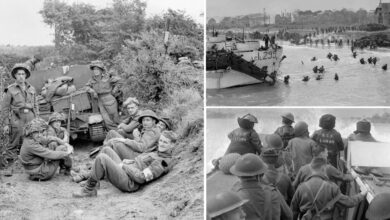History
Hill 70 Canada’s Forgotten Victory during the First World War
Above image: see cutlines below.
Just over 100 years ago today, the Canadian Corps attacked the city of Lens, France, on August 15, 1917, to relieve pressure on other Allied troops fighting near Passchendaele in Flanders.
The Canadians had become one of the best-trained and toughest attacking groups available on the Western Front, and after their success at Vimy Ridge, they had gained a new level of confidence.
Canadians lost more than 9,000 soldiers at Hill 70, but killed or wounded an estimated 25,000 Germans.
Dr. Tim Cook, director of research at the Canadian War Museum, and author, says he thinks the battle’s importance is primarily that it was the first major battle fought by Arthur Currie, the Canadian Corps Commander.
“Currie’s first battle was a significant Canadian victory, and one of the few times in the war where an attacking force, the Canadians, inflicted more damage on the defenders,” he continued.
Despite the battle being significant, it is known as the forgotten victory.
“I think up until just maybe the last five years or so, most Canadians had never heard of the battle of Hill 70. It wasn’t really talked about in our history books. Partially I think because it fell between those other big battles, Vimy and Passchendaele.”

In 2019, the Hill 70 Memorial at Loos-en-Gohelle near Lens, France, opened to the public to change this.
Six volunteers from Kingston, ON, raised over $12.5 million to build the memorial.
The centerpiece of the Memorial is an obelisk signifying the victory of the Canadian Corps at the Battle of Hill 70. In addition to the obelisk, there is a series of walkways dedicated to the six Victoria Cross awards, as well as plazas dedicated to Regiments and soldiers who figured prominently in the battle.
To mark the occasion Lawrence MacAulay, minister of veterans affairs and associate minister of national defence noted, “What the Canadian Corps accomplished at Hill 70 – their first major operation under a Canadian commander – remains one of Canada’s most significant military achievements. And though it came at an awful cost personal cost, Hill 70 helped continue to cement Canada’s growing reputation for bravery under fire as a leading force on the Western Front. It’s a legacy that has only grown stronger in the generations that have followed, and today – as ever – we remember them.”
British Field Marshal, Sir Douglas Haig, ordered attacks further to the south to divert German reinforcements away from Ypres, and the Passchendaele battlefield in Belgium. One of these, involving the First Army, would see the Canadian Corps attack Lens.
Haig ordered General Arthur Currie, who in June had been placed in command of the Canadian Corps, to launch a frontal assault on the city of Lens.
After studying the land, Currie made revisions to the plan, saying a better plan would be to capture Hill 70, directly to the north. If this dominating hill could be taken, the Germans would have no choice but to divert their troops and counterattack.

The attack was initially planned for the end of July, but it was postponed due to weather. In the meantime, the Canadian Corps increased preparations for the coming operation.
As part of its preparations, the Canadian Corps conducted raids against German outposts, and the Canadian gunners undertook a programme of wire-cutting, destroying German artillery positions and gas shelling.
Engineers also prepared special drums of oil to be used on the morning of the attack to create a smokescreen.
The infantry rehearsed their attack over similar terrain. But, unlike previous attacks, there was to be no sizeable preparatory barrage, which would have given the enemy warning of an impending operation.
The Canadians attacked on August 15 and captured many of their objectives, including the high ground. The Germans were forced to leave their trenches and attack over open ground, and the Canadians cut them down with mass artillery, fire, and machine guns.
The battle went on for 10 days with the Canadians not taking Lens, but they did secure Hill 70, and it remained in the allies’ hands until the end of the war.
They then held their positions against 21 determined German counterattacks over the next four days. Canadian probing attacks against Lens on August 21 and 23 were unsuccessful, as the Germans had anticipated the attack and, even under the heavy barrage, made the Canadian advance difficult. The attacks continued for the following days.
The battle went on for 10 days with the Canadians not taking Lens, but they did secure Hill 70, and it remained in the allies’ hands until the end of the war.
The attack also successful in pulling German reserves from the Ypres Salient, and gave the Canadians a reputation as being among the fiercest fighters on the Western Front.
Canadians lost more than 9,000 soldiers at Hill 70, but killed or wounded an estimated 25,000 Germans. Soon after, the Canadian Corps moved north to help Haig and his faltering Passchendaele campaign.
Six Canadians earned the Victoria Cross for bravery. To read more about Hill 70 and the monument visit here.










